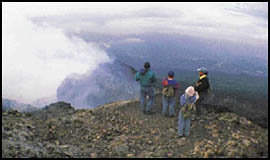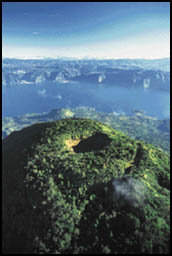 VOLCANOES VOLCANOES |
Thirty-seven sentinels, Guatemala's volcanoes, tower above the country's rugged landscape. Ascents are rewarded by a spectacular view, but each volcano also offers something unique and entirely its own. Of them all, only a few remain active. Their silhouettes under constant reshaping by the powerful eruptions that breach the earth's crust.

 Agua, Fuego & Acatenango Agua, Fuego & Acatenango |
Perhaps the most frequently photographed volcanoes in Guatemala, these three volcanoes watch over the colonial town of Antigua Guatemala. The stark cones of Agua and Acatenango attest to their slumbering old age, while the bare peak of Fuego and the small ash clouds rising from its summit are evidence of continuing activity. Hikes and birdwatching tours to Agua Volcano are offered by tour operators in Antigua.
 Pacaya Pacaya |
An active, unpredictable volcano, Pacaya dumped tons of volcanic sand and ash on Guatemala City in 1998. This volcano provides a constant show of ash clouds and lava flow. A number of tour operators offer guided excursions to Pacaya. Bear in mind that its activity is often unpredictable and can be dangerous. Responsible operators check vulcanological conditions first with the INSIVUMEH (Institute of Vulcanology, Meteorology, and Hydrology).
 Tolimán, Atitlán & San Pedro Tolimán, Atitlán & San Pedro |

These three majestic volcanoes towering above Lake Atitlán form the natural dam which contains the lake. At night, spectacular displays of lightning are sometimes seen beyond their cones. A smaller volcano, called Cerro de Oro, on the south side of the lake once contained a Maya fortress in its crater.
 Santa María and Santiaguito Santa María and Santiaguito |
Santa María is perhaps Guatemala's most beautiful
volcano, whose stately presence forms the lovely
backdrop of the city of Quetzaltenango. Santiaguito,
Guatemala's youngest and most dangerous volcano,
emerged on Santa María's southern flank with
a fierce eruption in 1902. The volcano frequently
spouts enormous clouds of ash, which can often be
seen from Quetzaltenango. At night, from the south
coast below, lava can be observed flowing from Santiaguito's
crater. It's best not to get too close, but a sfe
view of the crater can be had from the top of Santa
María, for those who don't mind a steep,
four-hour climb and camping overnight on a windswept
peak. |
 Chicabal Chicabal |
Found near Quetzaltenango, this volcano features a small lake with emerald green water in its crater. A sacred site for local inhabitants, the lake's forested shore has anumber of moss-covered wooden crosses placed among the trees. The lake can be reached in an easy day hike of about two hours.
 Ixtepeque Ixtepeque |

Found in the eastern department of Jutiapa, Ixtepeque is known for the vast quantities of black obsidian on its slopes. Prized by pre-Hispanic civilizations as a raw material for weapons, utensils and jewelry, the Ixtepeque obsidian is believed to have been traded throughout Guatemala, El Salvador, Honduras, and Mexico.
 Tajumulco & Tacaná Tajumulco & Tacaná |
Tajumulco is Central America's tallest volcano at 4,220 meters. Although seldom visited, the climb to the top is relatively easy, taking visitors through hamlets of shepherds and delightful pine glades, which are great places to pitch a tent and set up camp. Be forewarned, it gets very cold at night, so pack accordingly. The hardest part of the climb is the brief, but very steep, final ascent of the cone. The view from the summit is unsurpassed. Tacaná, on the Mexican border is not as tall, but is a difficult climb that attracts both Mexican and Guatemalan moutaineers.
All these informations are provided by courtesy of Destination Guatemala and Sol y Luna |

